Liquid-State Physical Chemistry by de With Gijsbertus

Author:de With, Gijsbertus [de With, Gijsbertus]
Language: eng
Format: epub
Publisher: Wiley
Published: 2013-07-07T14:00:00+00:00
Problem 10.14
Solid NO contains rectangular dimers with different side lengths. Estimate the residual entropy for NO.
Notes
1) We assume that edge effects can be neglected. We neglect also charge leakage through the capacitor.
2) We denote the polarization here by PE to avoid confusion with the pressure P. In the remainder of this chapter we just use P for the polarization.
3) The unit of dipole moment is C m, but often the Debye unit D is used, where 1 D = 3.336 × 10−30 C m.
4) The unit of polarizability is C2 m2 J−1. Often, the polarizability volume α′ = α/(4πε0) is used. Note that while αele represents the displacement of the electrons with respect to the nuclei, αmol represents the displacement of the molecule as a whole.
5) For a detailed general treatment, see Ref. [19]. In brief, the Hamilton function can be written as where P are the so-called “momentoids” (pseudo-momenta) associated with the orientation angles Q used as co-ordinates while p are the momenta associated with the other co-ordinates q. This procedure separates the rigid body rotational motion, which is independent of E and therefore can be omitted. But since P are not the real momenta associated with Q, this procedure introduces a Jacobian determinant sin θ for g(Q,q,E). This is in essence the procedure used here also.
6) A detailed discussion is given by Böttcher [1].
7) For molecules containing four or more atoms other internal mechanisms may operate; for example, inversion, as in NH3, or internal rotation, as in H2O2.
8) Note though that this model neglects the local topological constraints which slightly alter the statistical properties of the distribution in the neighbourhood of a site. The best series approximation for a 3D ice model yields S ≅ k ln(1.5068) [22].
9) The reaction H2O → 2H + O can be described as two consecutive reactions, H2O → OH + H with 119 kcal mol−1, and OH → O + H with 101 kcal mol−1. Accordingly, the average is 110 kcal mol−1.
10) Other materials that expand on freezing also have fourfold coordination, including Ga, Ge, Si, Bi, and RbNO3.
References
1 See Böttcher (1973).
2 Minkin, V.I., Osipov, O.A., and Zhadanov, Y.A. (1970) Dipole Moments in Organic Chemistry, Plenum, New York.
3 Petro, A.J. (1958) J. Am. Chem. Soc., 80, 4230.
4 Onsager, L. (1936) J. Am. Chem. Soc., 58, 1486.
5 Kirkwood, J.G. (1939) J. Chem. Phys., 7, 911.
6 Pople, J.A. (1951) Proc. Roy. Soc., A205, 163.
7 Coulson, C.A., and Eisenberg, D. (1966) Proc. Roy. Soc., A291, 445.
8 Niesar, U., Corongiu, G., Clementi, E., Kneller, G.R., and Bhattacharya, D.K. (1990) J. Phys. Chem., 94, 7949.
9 Pauling, L. (1960) The Nature of Chemical Bond, 3rd edn, Cornell, Ithaca, NY., Ch. 12.
10 Praprotnik, M., Janezic, D., and Mavri, J. (2004) J. Phys. Chem., A108, 11056.
11 Vega, C. and Abascal, J.L.F. (2011) Phys. Chem. Chem. Phys., 13, 19663.
12 (a) Paesani, F. and Voth, G.A. (2009) J. Phys. Chem., B113, 5702; (b) Medders, G.R., Babin, V., and Paesani, F. (2013) J. Chem. Theory Comp. 9, 1103.
13 Morgan, J. and Warren, B.E. (1938) J.
Download
This site does not store any files on its server. We only index and link to content provided by other sites. Please contact the content providers to delete copyright contents if any and email us, we'll remove relevant links or contents immediately.
Whiskies Galore by Ian Buxton(41882)
Introduction to Aircraft Design (Cambridge Aerospace Series) by John P. Fielding(33064)
Rewire Your Anxious Brain by Catherine M. Pittman(18554)
Craft Beer for the Homebrewer by Michael Agnew(18145)
Cat's cradle by Kurt Vonnegut(15189)
Sapiens: A Brief History of Humankind by Yuval Noah Harari(14254)
Leonardo da Vinci by Walter Isaacson(13188)
The Tidewater Tales by John Barth(12609)
Thinking, Fast and Slow by Kahneman Daniel(12080)
Underground: A Human History of the Worlds Beneath Our Feet by Will Hunt(12026)
The Radium Girls by Kate Moore(11926)
The Art of Thinking Clearly by Rolf Dobelli(10229)
A Journey Through Charms and Defence Against the Dark Arts (Harry Potter: A Journey Throughâ¦) by Pottermore Publishing(9233)
Mindhunter: Inside the FBI's Elite Serial Crime Unit by John E. Douglas & Mark Olshaker(9206)
Tools of Titans by Timothy Ferriss(8222)
Wonder by R. J. Palacio(8012)
Turbulence by E. J. Noyes(7940)
Change Your Questions, Change Your Life by Marilee Adams(7637)
Nudge - Improving Decisions about Health, Wealth, and Happiness by Thaler Sunstein(7622)
